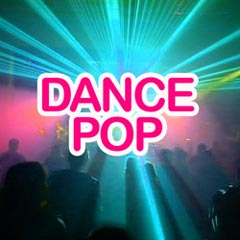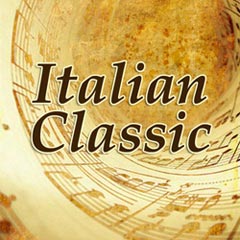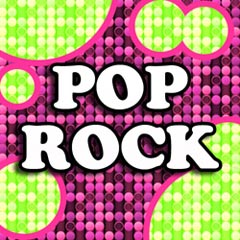Dance pop
ON AIR - PROGRAMMING
The marriage of commercial with dance, this is dance pop in its most pure and simple form, not looking to be anything more. Simple, memorable, danceable, and popular. the dance music is a mix of disco music and pop songs, born in the 1980s to be played in nightclubs and broadcast on the radio. Melody and catchy tunes are the core of this music genre.Moving and grooving, bump and grinding, pushing one's body to its limits. These are telltale signs of dance music and all it has come to represent. It is ingrained in the fabric of any celebration or festival. Whether it be the professional dancer, a passionate enthusiast, or simply someone wanting to have a good time shaking their booty on the dance floor, no matter what style you prefer to move toÑif it has a beat chances are it's daaance music! To some, dancing is an escape. A way of leaving everyday troubles behind as they enter into another world. For others, dance brings competition and challenges them to always become better. Whatever your interpretation may be something unifies us: we all love music that lets us let go! A playlist with dance music songs, from the 70s disco music till the 90s dance songs, here you can find a mix of all generation dance music.
The Rise of Dance Pop: A Blend of Pop and Disco Music
As the years advance, dance pop music is becoming more mainstream. The simple, catchy, and danceable tunes have become a significant part of the pop culture in the 21st century. The blend of disco music and pop songs, which first emerged in the 1980s, has grown to become the perfect genre for nightclubs, festivals, and broadcasting on the radio. It is no doubt that dance pop music has come a long way, and in this article, we will explore the genre's roots, its evolution, and what makes it so unique.
The marriage of commercial and dance is what makes dance pop in its most simple form. With its infectious beats and catchy melodies, it found its place among listeners who enjoy dancing and groove to the sound. Disco music is what inspired the birth of dance pop, and it is no wonder that this music genre has such an iconic sound. The likes of Michael Jackson, Madonna, and Janet Jackson started their careers in the 80s with dance pop music. The term dance pop first appeared in the early 1990s, becoming an instant buzzword in the music industry.
Dance pop is a fusion of sounds, blending disco and pop in one genre. Such a mix of sounds makes it easy to dance to and super memorable. The simple and repetitive tunes make dance pop music accessible to any music listener, and in turn, it became an excellent tool for radio music. Dance pop rapidly evolved from the 80s, where it was only played in nightclubs to being played on the radio in the 90s. Over time, the genre has also been incorporated into movies, TV shows, and commercials, thus increasing its popularity.
Dance pop has always been about dancing, mostly at nightclubs or discotheques. With the rise of festivals, dance pop became a staple for big crowds and outdoor events. In festivals, the energy and vibe offered by dance pop music is unlike any other genre, creating an unbeatable atmosphere. One of the reasons for dance pop's popularity in festivals is the live performances. It gives the audience an experience of a lifetime, which creates memorable moments. From the outfit, dance moves, to the energy on stage, it's no wonder that dance pop has become a must-have genre for any festival.
Dance pop has undergone changes from the 80s, but it still holds its core values: being simple, danceable, and memorable. The blending of sounds has enabled dance pop to adapt to different music trends, which is why it still has a place in the music industry today. It has undergone various remixes and collaborations with some of the biggest names in the music industry. The rise of social media and streaming platforms has further boosted dance pop's popularity. Listeners from across the world can access and stream dance pop songs with just a click, thus increasing its outreach.
Dance pop has grown exponentially in the music industry, becoming a genre that cuts across different cultures and ages. It provides an escape from everyday life and a platform for people to come together and express themselves through dance. The fusion of disco and pop music has given us some of the world's most memorable tunes. It's easy to learn the lyrics, sing along, and make dance moves that are quickly recognized on the dance floor. The rise of dance pop is not ending anytime soon, and one can only hope that it continues to give us the same energy and vibe that it's known for.
The Rise of Dance Pop: A Blend of Pop and Disco Music
As the years advance, dance pop music is becoming more mainstream. The simple, catchy, and danceable tunes have become a significant part of the pop culture in the 21st century. The blend of disco music and pop songs, which first emerged in the 1980s, has grown to become the perfect genre for nightclubs, festivals, and broadcasting on the radio. It is no doubt that dance pop music has come a long way, and in this article, we will explore the genre's roots, its evolution, and what makes it so unique.
The marriage of commercial and dance is what makes dance pop in its most simple form. With its infectious beats and catchy melodies, it found its place among listeners who enjoy dancing and groove to the sound. Disco music is what inspired the birth of dance pop, and it is no wonder that this music genre has such an iconic sound. The likes of Michael Jackson, Madonna, and Janet Jackson started their careers in the 80s with dance pop music. The term dance pop first appeared in the early 1990s, becoming an instant buzzword in the music industry.
Dance pop is a fusion of sounds, blending disco and pop in one genre. Such a mix of sounds makes it easy to dance to and super memorable. The simple and repetitive tunes make dance pop music accessible to any music listener, and in turn, it became an excellent tool for radio music. Dance pop rapidly evolved from the 80s, where it was only played in nightclubs to being played on the radio in the 90s. Over time, the genre has also been incorporated into movies, TV shows, and commercials, thus increasing its popularity.
Dance pop has always been about dancing, mostly at nightclubs or discotheques. With the rise of festivals, dance pop became a staple for big crowds and outdoor events. In festivals, the energy and vibe offered by dance pop music is unlike any other genre, creating an unbeatable atmosphere. One of the reasons for dance pop's popularity in festivals is the live performances. It gives the audience an experience of a lifetime, which creates memorable moments. From the outfit, dance moves, to the energy on stage, it's no wonder that dance pop has become a must-have genre for any festival.
Dance pop has undergone changes from the 80s, but it still holds its core values: being simple, danceable, and memorable. The blending of sounds has enabled dance pop to adapt to different music trends, which is why it still has a place in the music industry today. It has undergone various remixes and collaborations with some of the biggest names in the music industry. The rise of social media and streaming platforms has further boosted dance pop's popularity. Listeners from across the world can access and stream dance pop songs with just a click, thus increasing its outreach.
Dance pop has grown exponentially in the music industry, becoming a genre that cuts across different cultures and ages. It provides an escape from everyday life and a platform for people to come together and express themselves through dance. The fusion of disco and pop music has given us some of the world's most memorable tunes. It's easy to learn the lyrics, sing along, and make dance moves that are quickly recognized on the dance floor. The rise of dance pop is not ending anytime soon, and one can only hope that it continues to give us the same energy and vibe that it's known for.
2023-01-06
Dance music over the years
Every genre of music always has its rise and fall in terms of popularity. It also happened in disco music, which in the 1970s achieved its peak as the popular genres in many countries of the world. However, the term disco finally gets outwitted during the 1980s, after following the emergence of some of the new subgenres of music, and one of them is dance-pop music. Basically, dance-pop music combines dance and pop music, which have simpler nuance with pop songs forms and dance energetic and up-tempo beats. Hence, dance-pop music becomes one of the popular genres at that time. So, it can be seen that Dance-pop music itself is rooted in the disco. The distinctive characteristic of Dance-pop music is uptempo, which designed for club songs. It also employed the hooks, a short, catchy passage intended to makes the audience easy to remember. Due to this reason, dance-pop music becomes versatile, which means that it can be played in the clubs and also in contemporary radios. During the early emergence of dance-pop music in the 1980s, some of the artists also employed the elements from other genres, for example, Michael Jackson and Whitney Houston who have the funk influences in their dance-pop music, or Janet Jackson who combines dance-pop with swingbeat.
Dance-pop music becomes a mainstream popular genre during the 1990s. Many western girl band and boyband emerged during this era, as the famous ones are Spice Girls and Backstreet Boys. The pop singers such as Madonna, Britney Spears, and Christina Aguilera also produce some songs which are considered as dance-pop music. For example, the dance-pop uptempo nuance can be seen in Madonna’s Vogue and Deeper and Deeper and Christina Aguilera’s Xtina’s Xmas and The Christmas Song (Holiday Remix). Hence, with all of these highly qualified artists, dance-pop music become one of the major trends during the 1990s. Some of the artists also tried to incorporate their music with dance-pop, for instance, Cher. Her album entitled Believe, received a considerable commotion worldwide, and her name peaked as one of the top pop artists and critically acclaimed as one of the best divas of all time. Cher also becomes the first singers who utilize the technology called autotune. All of these artists remain dominant in the music industry during the early 2000s.
During this era, dance-pop is affiliated with the heavy influence of other electronic music genres, for example, trance, house, and techno. One of the evolutionists of dance music is Lady Gaga with her Just Dance and Poker Face, while Rihanna, one of the notable dance-pop artists, also has the influence of the electronic music in her Don’t Stop the Music. Several new significant-top dance-pop musicians during this 2000s-2010s are Katy Perry (my personal favorite), Ariana Grande, and Taylor Swift. Most of the dance-pop musicians are not entirely emphasize on dance-pop subgenres only, but also experiment in other electronic music, which makes this music has distinctive personal styles for each musician. As dance-pop musicians’ best artists can be considered as abundant, try to listen to some Michael Jackson’s work and Whitney Houston for the 1980s dance-pop. Consider the Christina Aguilera, Madonna, and Cher as a must for the 1990s dance-pop. From the 2000s onwards, there will be many artists, but Katy Perry is my personal favorite. Happy listening!
Dance-pop music becomes a mainstream popular genre during the 1990s. Many western girl band and boyband emerged during this era, as the famous ones are Spice Girls and Backstreet Boys. The pop singers such as Madonna, Britney Spears, and Christina Aguilera also produce some songs which are considered as dance-pop music. For example, the dance-pop uptempo nuance can be seen in Madonna’s Vogue and Deeper and Deeper and Christina Aguilera’s Xtina’s Xmas and The Christmas Song (Holiday Remix). Hence, with all of these highly qualified artists, dance-pop music become one of the major trends during the 1990s. Some of the artists also tried to incorporate their music with dance-pop, for instance, Cher. Her album entitled Believe, received a considerable commotion worldwide, and her name peaked as one of the top pop artists and critically acclaimed as one of the best divas of all time. Cher also becomes the first singers who utilize the technology called autotune. All of these artists remain dominant in the music industry during the early 2000s.
During this era, dance-pop is affiliated with the heavy influence of other electronic music genres, for example, trance, house, and techno. One of the evolutionists of dance music is Lady Gaga with her Just Dance and Poker Face, while Rihanna, one of the notable dance-pop artists, also has the influence of the electronic music in her Don’t Stop the Music. Several new significant-top dance-pop musicians during this 2000s-2010s are Katy Perry (my personal favorite), Ariana Grande, and Taylor Swift. Most of the dance-pop musicians are not entirely emphasize on dance-pop subgenres only, but also experiment in other electronic music, which makes this music has distinctive personal styles for each musician. As dance-pop musicians’ best artists can be considered as abundant, try to listen to some Michael Jackson’s work and Whitney Houston for the 1980s dance-pop. Consider the Christina Aguilera, Madonna, and Cher as a must for the 1990s dance-pop. From the 2000s onwards, there will be many artists, but Katy Perry is my personal favorite. Happy listening!
Tag: dance music, dance songs, disco music, house
What are you thinking about?






